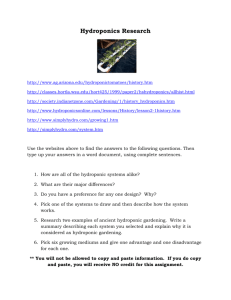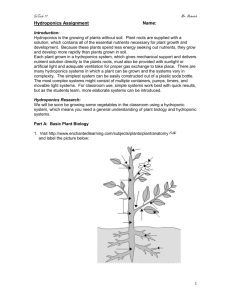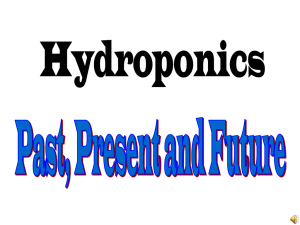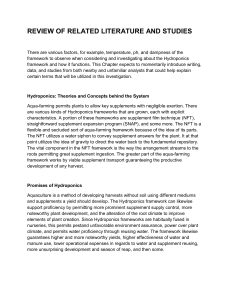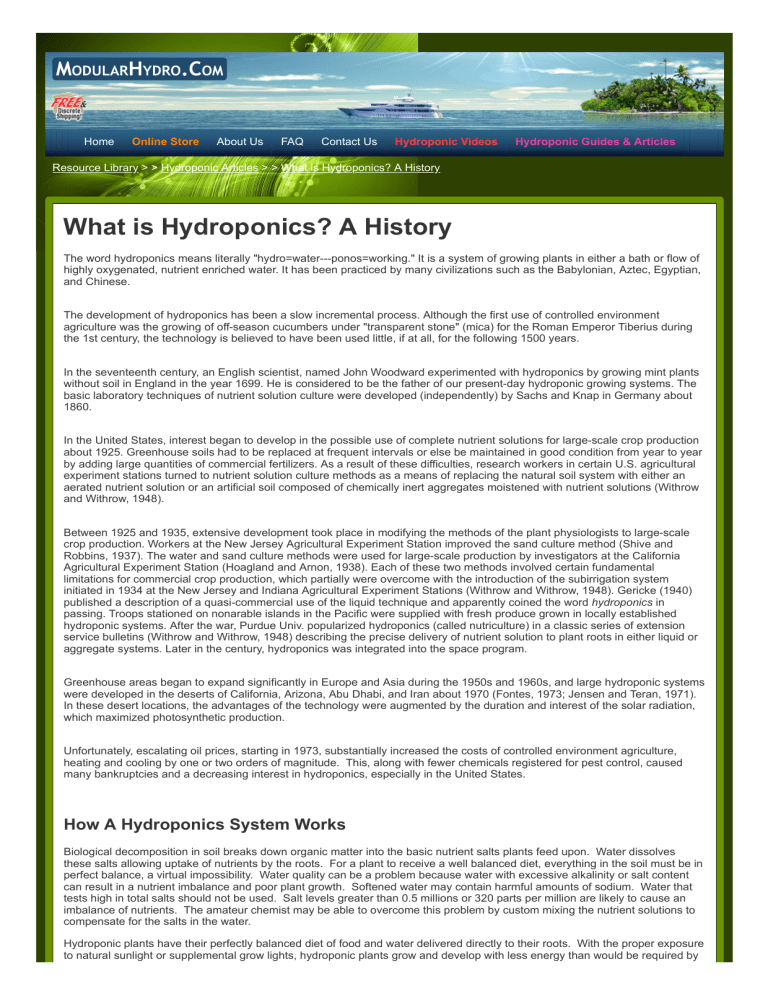
MODULARHYDRO.COM Home Online Store About Us FAQ Contact Us Hydroponic Videos Hydroponic Guides & Articles Resource Library > > Hydroponic Articles > > What is Hydroponics? A History What is Hydroponics? A History The word hydroponics means literally "hydro=water---ponos=working." It is a system of growing plants in either a bath or flow of highly oxygenated, nutrient enriched water. It has been practiced by many civilizations such as the Babylonian, Aztec, Egyptian, and Chinese. The development of hydroponics has been a slow incremental process. Although the first use of controlled environment agriculture was the growing of off-season cucumbers under "transparent stone" (mica) for the Roman Emperor Tiberius during the 1st century, the technology is believed to have been used little, if at all, for the following 1500 years. In the seventeenth century, an English scientist, named John Woodward experimented with hydroponics by growing mint plants without soil in England in the year 1699. He is considered to be the father of our present-day hydroponic growing systems. The basic laboratory techniques of nutrient solution culture were developed (independently) by Sachs and Knap in Germany about 1860. In the United States, interest began to develop in the possible use of complete nutrient solutions for large-scale crop production about 1925. Greenhouse soils had to be replaced at frequent intervals or else be maintained in good condition from year to year by adding large quantities of commercial fertilizers. As a result of these difficulties, research workers in certain U.S. agricultural experiment stations turned to nutrient solution culture methods as a means of replacing the natural soil system with either an aerated nutrient solution or an artificial soil composed of chemically inert aggregates moistened with nutrient solutions (Withrow and Withrow, 1948). Between 1925 and 1935, extensive development took place in modifying the methods of the plant physiologists to large-scale crop production. Workers at the New Jersey Agricultural Experiment Station improved the sand culture method (Shive and Robbins, 1937). The water and sand culture methods were used for large-scale production by investigators at the California Agricultural Experiment Station (Hoagland and Arnon, 1938). Each of these two methods involved certain fundamental limitations for commercial crop production, which partially were overcome with the introduction of the subirrigation system initiated in 1934 at the New Jersey and Indiana Agricultural Experiment Stations (Withrow and Withrow, 1948). Gericke (1940) published a description of a quasi-commercial use of the liquid technique and apparently coined the word hydroponics in passing. Troops stationed on nonarable islands in the Pacific were supplied with fresh produce grown in locally established hydroponic systems. After the war, Purdue Univ. popularized hydroponics (called nutriculture) in a classic series of extension service bulletins (Withrow and Withrow, 1948) describing the precise delivery of nutrient solution to plant roots in either liquid or aggregate systems. Later in the century, hydroponics was integrated into the space program. Greenhouse areas began to expand significantly in Europe and Asia during the 1950s and 1960s, and large hydroponic systems were developed in the deserts of California, Arizona, Abu Dhabi, and Iran about 1970 (Fontes, 1973; Jensen and Teran, 1971). In these desert locations, the advantages of the technology were augmented by the duration and interest of the solar radiation, which maximized photosynthetic production. Unfortunately, escalating oil prices, starting in 1973, substantially increased the costs of controlled environment agriculture, heating and cooling by one or two orders of magnitude. This, along with fewer chemicals registered for pest control, caused many bankruptcies and a decreasing interest in hydroponics, especially in the United States. How A Hydroponics System Works Biological decomposition in soil breaks down organic matter into the basic nutrient salts plants feed upon. Water dissolves these salts allowing uptake of nutrients by the roots. For a plant to receive a well balanced diet, everything in the soil must be in perfect balance, a virtual impossibility. Water quality can be a problem because water with excessive alkalinity or salt content can result in a nutrient imbalance and poor plant growth. Softened water may contain harmful amounts of sodium. Water that tests high in total salts should not be used. Salt levels greater than 0.5 millions or 320 parts per million are likely to cause an imbalance of nutrients. The amateur chemist may be able to overcome this problem by custom mixing the nutrient solutions to compensate for the salts in the water. Hydroponic plants have their perfectly balanced diet of food and water delivered directly to their roots. With the proper exposure to natural sunlight or supplemental grow lights, hydroponic plants grow and develop with less energy than would be required by a “stem to root” system. A soil-free medium like fiber, sand, perlite, coco fiber, or stone, may be used to anchor the roots. These mediums are very porous affording excellent retention of air and water and allowing roots to breathe, a necessity for healthy plants. Air circulation around leaves is important since it mixes the air and allows the plant to draw out the carbon dioxide necessary to carry on photosynthesis. Air circulation also helps prevent fungal diseases caused by moist, stagnant conditions. Indoor units often have a small fan to circulate the surrounding air. In hydroponic agriculture, water is enriched with these nutrient salts, creating a hydroponic nutrient solution that is perfectly balanced. Very little water is lost to evaporation, making its application in drought stricken areas a perfect solution to overcoming arid conditions. Hydroponic technology can efficiently generate food crops from barren desert sand and desalinated ocean water, in mountainous regions too steep to farm, on city rooftops and concrete schoolyards, in urban backyards, indoors anywhere in the world, and in arctic communities Some of the positive attributes of hydroponic agriculture are: The ability to produce higher yields than traditional, soil-based agriculture; Allowing food to be grown in areas of the world that cannot support soil crops; Multiple crop availability, overcoming “seasonal” crop requirements. Quicker and more vigorous growth; Gardens and growing systems that are portable; Ease of harvesting resulting in less need for labor; Eliminating the need for massive use of pesticides thereby making our air, water, soil, and food cleaner and providing safety for fauna. It is fun, a learning experience, and an enjoyable family project. While removing soil-grown crops from the ground effectively kills them, hydroponically grown crops such as lettuce, basil, etc. can be packaged and sold while still alive, thus prolonging its effective marketing. Solution culture hydroponics does not require disposal of a solid medium or sterilization and reuse of a solid medium. Solution culture hydroponics allows greater control over the root zone environment than soil culture. Hydroponics is often the best crop production method in remote areas that lack suitable soil. In solution culture hydroponics, plant roots can be seen. Hydroponics is excellent for plant teaching and research. Soil borne diseases are virtually eliminated. Weeds are virtually eliminated. Fewer pesticides may be required because of the above two reasons and also it results in making our air, water, soil, and food cleaner and providing safety for fauna. Edible crops are not contaminated with soil. Water use can be substantially less than with outdoor irrigation of soil-grown crops. Hydroponics cost 20% less than other ways for growing certain food products. Many hydroponic systems give the plants more nutrition while at the same time using less energy and space. Hydroponics allow for easier fertilization as it is possible to use an automatic timer to fertilize the plants. It provides the plant with balanced nutrition because the essential nutrients are dissolved into the water-soluble nutrient solution. The plants will be healthier and the yields will be higher. Hydroponics also saves an incredible amount of water. It uses as little as 1/20 the amount as a regular farm to produce the same amount of food. Plants can be grown in smaller areas, and can be stacked vertically, horizontally, and in many configurations that make the most efficient use of available space. Hydroponic systems can flourish in greenhouses, outdoors with certain protections, indoors, on patios and porches, and are not limited by space. Most growing mediums can be used more than once, thus lowering the cost of components of the system. Temperature fluctuations, wind damage, over and under watering, excess sunlight, and lack of sufficient light can be managed in hydroponic growing systems. Shade cloth can easily be installed with special clips, and removed at will thereby totally managing the light source to the plants. For very ambitious gardeners, the hydroponic mechanical components can be operated by using solar energy, therefore, the cost of operation is only for the nutrients and obtaining water. Hydroponics can be done on a commercial basis, or can be a hobby and is a flexible method of growing easily adaptable to your personal space and/or to accomplish your project goal. The only maintenance required to manage hydroponic systems is to check the values of the nutrients on a regular basis, make sure the solution is at the proper level. If timers or electric pumps fail or the system clogs or springs a leak, timely attention will preserve the integrity of the plants. Hydroponics, except for commercial applications, usually does not require great technical knowledge. Multiple crop availability, overcoming “seasonal” crop requirements. Quicker and more vigorous growth; Gardens and growing systems that are portable; Ease of harvesting resulting in less need for labor; You can automate the system so that you will not have to worry about watering your plants while you're on vacation. It is fun, a learning experience, and an enjoyable family project. Seeds and Seedlings Seedlings that will be transferred into a hydroponics grow channel can be grown with their roots exposed or in root cubes. It is best to grow them with exposed roots if they are to be grown in a water culture system. Sow the seeds in quartz sand, coarse vermiculite, cellulose fiber, rockwool cubes, or perlite. These cubes provide weight and help support the plant. Water the seeds and cover them with wet paper towels or cheesecloth until they germinate. Then remove the covering and thin the plants. Moisten them as needed with a dilute nutrient solution infused with the appropriate amount of hydrogen peroxide, rather than water because the germination medium does not provide adequate nutrition. A one-fourth concentration of the nutrient solution recommended in the next section may be used. When the seedlings are large enough to transplant, gently wash the growing medium from their roots. Nutrient Solutions The absolute ideal hydroponic system is one that is installed in a greenhouse. That environment enables the gardener to control temperature and humidity, protects the plantings from wind, excessive rain, and too much or not enough light. Many garden centers and home improvement stores have very inexpensive small greenhouses that are easy to assemble and come in a variety of sizes and shapes. Check it out! The future of soilless agriculture will be the object of attention by entrepreneurs and innovators as better methods of growing plants are sought for profit and to promote ecologically safe and non-polluting plant production. The technology of hydroponic systems is changing rapidly with systems today producing yields never before realized. This technology allows you to grow where no one has grown before, be it underground, or above, in space or under the oceans this technology will allow humanity to live where humanity chooses. If used for our own survival or our colonization, hydroponics is and will be a major part of our collective future. The future for hydroponics appears more positive today than any time over the last 50 years. I sincerely believe hydroponics is fashionable again commercially. As a family project, in the process of maintaining a hydroponic system, you will be furnished food for the table, flowers for your vases, and experimental growing as a teaching tool popular in this “go green” economy. From a practical standpoint, as the systems become more user friendly, easier to operate, less expensive, and readily available, many more people will turn to hydroponics for basic needs and also as an interesting and useful hobby. Some material cited from “Hydroponics” by Merle H. Jensen Department of Plant Sciences, University of Arizona, Tucson, AZ 85721 View Video Library View Article Library View Our Online Store Site Map ModularHydro.com FAQ About Us Contact Us How To Guides & Videos Visit Our Online Store Hydroponic Resources >Hydroponic Videos >Hydroponic Articles >Product Reviews (C) 2011 ModularHydro.com Web Design, Development, and Marketing
